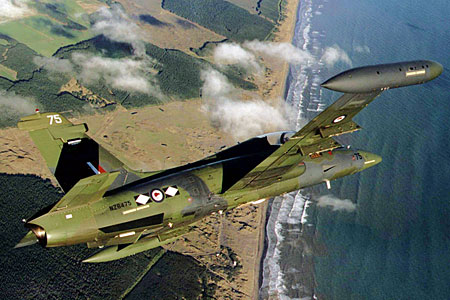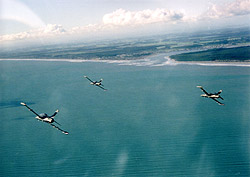Home | Airshows | The Hangar | Nostalgia | Links
 Kiwis
can fly!
Kiwis
can fly!
Mike Jorgensen/Action Air Images recalls his own Aermacchi experiences with the RNZAF
In 1996, when I was 24 years old, I was lucky enough to be selected for pilot training in the Royal New Zealand Air Force. Following six months of courses consisting of boot polishing, marching, aviation medicine and survival training, etc., I was finally airborne in the 210hp piston engined Airtrainer, at the RNZAF Base Ohakea. This all-metal aerobatic machine was a delightful aircraft, capable of aerobatics in the +6G and -3G range, and could even sustain inverted spins. Night flying, instrument flying, low-level navigation and formation flying was all rigorously tested by my enthusiastic instructors, and after 120 hours of course flying I was streamed to fly jets.
 The
RNZAF at the time operated the A-4K Skyhawk as its attack aircraft, and
these little jets had been updated in the 1980s with a Head Up Display
(HUD) and a radar, making them an even more potent machine. Before I could
even think of flying these however, I first had to complete a number of
courses on the Aermacchi MB-339CB.
The
RNZAF at the time operated the A-4K Skyhawk as its attack aircraft, and
these little jets had been updated in the 1980s with a Head Up Display
(HUD) and a radar, making them an even more potent machine. Before I could
even think of flying these however, I first had to complete a number of
courses on the Aermacchi MB-339CB.
Wings Course at No 14 Squadron once again consisted of aerobatics, formation, instrument flying, low and high level navigation sorties - but at a much faster pace than I had ever experienced on the Airtrainer. The Macchi's 4200 lbs thrust engine had no trouble pushing me at 450 knots at low level straight and level flight, and would certainly exceed Vne (maximum speed 500kts or Mach 0.82) in a gentle dive. However navigation sorties were normally planned at 300 knots, so that my brain had a chance of keeping up at a rate of 1 mile per 12 seconds, and also so that extra speed was available 'on tap' in order to make up for lost time if late.
 Aerobatics
were certainly made a little easier with the use of the HUD. Exact cues
were available to accurately measure the nose attitude in reference to
the horizon (whether we could actually see it or not) and the HUD camera
recorded our errors and wayward comments for review after flight. Although
rated at +7.3G and -4G, we were restricted to +6G and -3G. This ensured
a longer fatigue life, and helped keep a buffer from the limits in our
hamfisted ways. Regardless, the jet could easily maintain 6G in a turn
all day (or at least until the fuel lasted), and my personal fatigue was
normally the limiting factor. As long as no fuel imbalance was observed
in the tip fuel tanks, spinning was authorised when with an instructor.
The inverted spin was even achievable, and the little jet was very well
behaved in this element. A comprehensive brief was always announced before
each and every spin, announcing spin direction and recovery actions, as
was the height of mandatory ejection if recovery was not achieved. Luckily
nobody ever had to abandon the Macchi during spinning, it always recovered
'as advertised'.
Aerobatics
were certainly made a little easier with the use of the HUD. Exact cues
were available to accurately measure the nose attitude in reference to
the horizon (whether we could actually see it or not) and the HUD camera
recorded our errors and wayward comments for review after flight. Although
rated at +7.3G and -4G, we were restricted to +6G and -3G. This ensured
a longer fatigue life, and helped keep a buffer from the limits in our
hamfisted ways. Regardless, the jet could easily maintain 6G in a turn
all day (or at least until the fuel lasted), and my personal fatigue was
normally the limiting factor. As long as no fuel imbalance was observed
in the tip fuel tanks, spinning was authorised when with an instructor.
The inverted spin was even achievable, and the little jet was very well
behaved in this element. A comprehensive brief was always announced before
each and every spin, announcing spin direction and recovery actions, as
was the height of mandatory ejection if recovery was not achieved. Luckily
nobody ever had to abandon the Macchi during spinning, it always recovered
'as advertised'.
After 80
hours of the Wings course I was awarded my Pilot Brevet, and moved onto
the Operational Conversion course. This consisted of another 80 hours
of flying, where I was taught to employ the Macchi as an airborne  weapons
delivery platform. Air-to-air manoeuvres and air-to-ground attack flying
were practised, in combination with one or more other supporting jets,
and sometimes with enemy Macchis waiting to test my lookout, and shooting
me from all angles at the most inopportune moments. Friendly Macchis and
enemy Macchis can be very hard to distinguish at times - and often with
embarrassing outcomes. Weapons delivered onto the range included the .50
calibre machine gun, rockets, and practice high and low drag bombs. We
also 'simulated' the firing of AIM-9 Sidewinder missiles and guns during
the air combat phase. All of this was very rewarding work - yet difficult.
Unfortunately my course mate was removed from training, and re-roled towards
multi-engine flying.
weapons
delivery platform. Air-to-air manoeuvres and air-to-ground attack flying
were practised, in combination with one or more other supporting jets,
and sometimes with enemy Macchis waiting to test my lookout, and shooting
me from all angles at the most inopportune moments. Friendly Macchis and
enemy Macchis can be very hard to distinguish at times - and often with
embarrassing outcomes. Weapons delivered onto the range included the .50
calibre machine gun, rockets, and practice high and low drag bombs. We
also 'simulated' the firing of AIM-9 Sidewinder missiles and guns during
the air combat phase. All of this was very rewarding work - yet difficult.
Unfortunately my course mate was removed from training, and re-roled towards
multi-engine flying.
Low level
flying started at 250 feet, and I was slowly moved down to 100 feet, and
eventually down to 50 feet. Although this was initially a little daunting
when flying over the sea, it was much harder when flying throughout New
Zealand's vast valleys, when watching over my shoulder for the attacking
jets. Add to that the tasks of map reading, following the lead aircraft,
actually avoiding the ground and operating the jet's systems, and you
 can
begin to appreciate the complexity of the task. Not a job for the faint-at-heart.
Post-flight debriefs were very extensive, and every aspect of your performance
(or lack of) was picked apart. Rather than let it get you down however,
it provided incentive to get it right next time. Next time your life may
depend on it.
can
begin to appreciate the complexity of the task. Not a job for the faint-at-heart.
Post-flight debriefs were very extensive, and every aspect of your performance
(or lack of) was picked apart. Rather than let it get you down however,
it provided incentive to get it right next time. Next time your life may
depend on it.
After completion of the Operational Conversion I remained on squadron in order to gain experience before starting the A-4K Skyhawk conversion. Sorties flown included anti-ship, close air support, dissimilar air combat with Skyhawks and Australian F/A-18A Hornets, formation flypasts, and the odd scenic navigational flight. I was even lucky enough to perform chase jet duties for a week of Hercules test flights. On the last day an Air Force photographer was kind enough to sit on the C-130 ramp and shoot some head-on photos of me whilst I closed on in.
 During
all of this fun flying it was announced that New Zealand had secured a
deal where we would lease F-16s from the USA. Morale was at an all-time
high, and all Skyhawk conversions were stopped. The pilots were busy hitting
the weights room in the gym, in preparation for building strength in order
to combat the F-16 high G-forces. Unfortunately the Labour government
gained power and the F-16 deal was cancelled, as was eventually the entire
Strike Force capability. The A-4s and Macchis have been put up for sale,
with only limited operations taking place nowadays in order to keep some
demonstration airframes in flying condition. It was a very sad situation,
with most of the pilots gaining flying jobs in overseas companies and
militaries. The Strike Role in New Zealand will never be achievable again.
During
all of this fun flying it was announced that New Zealand had secured a
deal where we would lease F-16s from the USA. Morale was at an all-time
high, and all Skyhawk conversions were stopped. The pilots were busy hitting
the weights room in the gym, in preparation for building strength in order
to combat the F-16 high G-forces. Unfortunately the Labour government
gained power and the F-16 deal was cancelled, as was eventually the entire
Strike Force capability. The A-4s and Macchis have been put up for sale,
with only limited operations taking place nowadays in order to keep some
demonstration airframes in flying condition. It was a very sad situation,
with most of the pilots gaining flying jobs in overseas companies and
militaries. The Strike Role in New Zealand will never be achievable again.
Regardless, the Aermacchi 339 was such a fantastic trainer, and it will always remain a fond memory. I hope to have the chance to fly one again, just one more time.
Home | Airshows | The Hangar | Nostalgia | Links